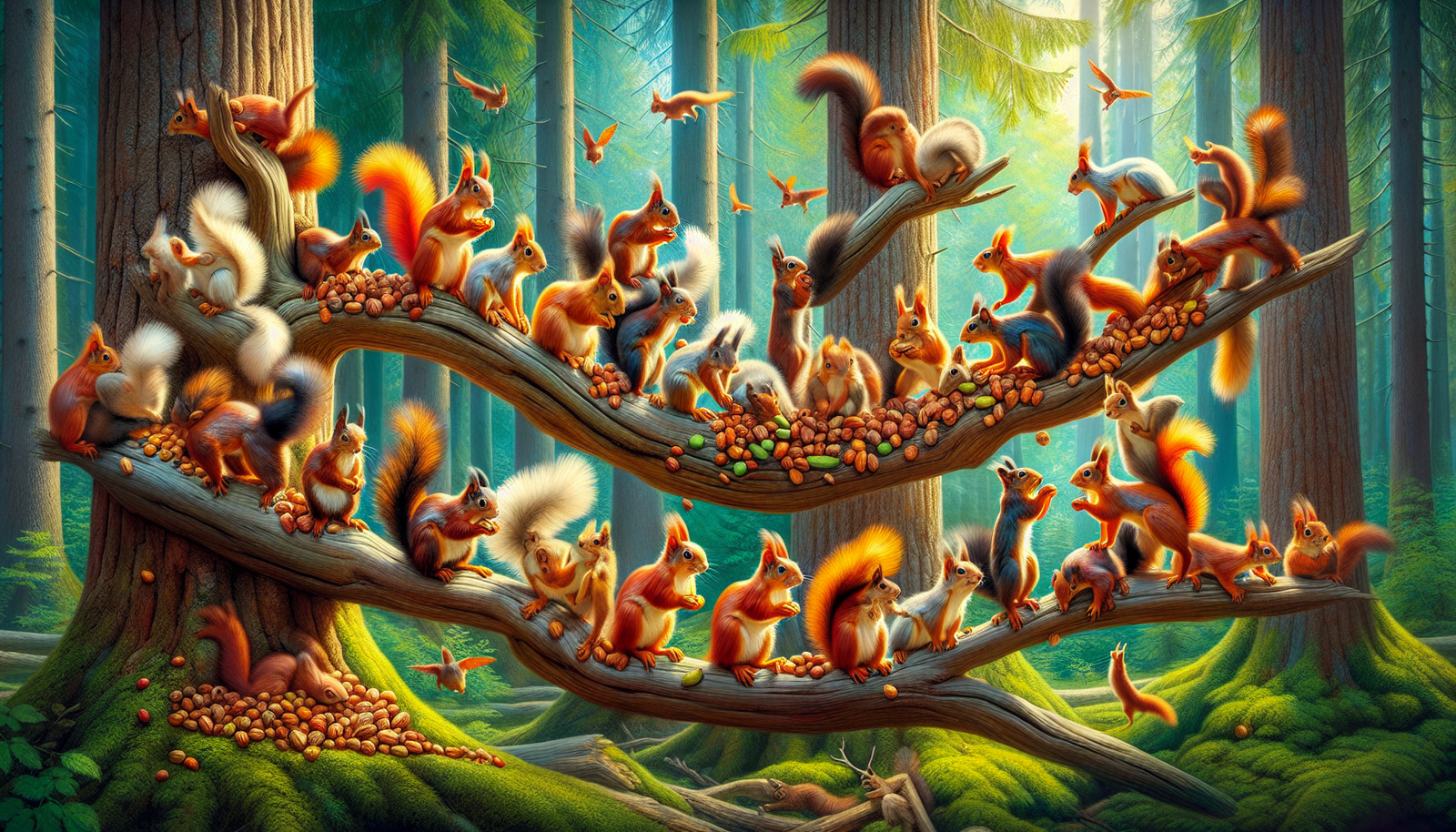Have you ever stumbled upon a flurry of bushy tails and curious eyes during a walk in the park and wondered what collective name our furry friends squirrels go by? Let’s unravel this mystery straight away: a group of squirrels, those endearing creatures that caper about in trees and sometimes venture into our backyards, is most often called a “scurry” or a “dray.” But why should we care, and what does it tell us about their covert social lives? Stick with me as we delve into the enchanting social tapestry woven by these charming woodland acrobats.
What is a Group of Squirrels Called?
Akin to a “murder” of crows or a “pride” of lions, the term squirrel conjures up images of a solitary creature, often seen in isolation. Yet, in nature, squirrels do come together, and when they do, they form what is known as a “scurry” or less commonly, a “dray”. The squirrel collective noun actually provides insight into the squirrel social structure. By exploring the squirrel community name or squirrel family name, we can better understand these nimble and resourceful rodents.
Historical Background of the Term
The origins of collective nouns for animals, including the squirrel pack name, are often rooted in the Old English tradition and were solidified in texts like “The Book of Saint Albans” published in the 15th century. These terms were poetic and reflective of the characteristics seen in these animals, thus “scurry” mirrors the hurried movements of a squirrel, and “dray” refers to a nest, which could imply a home or a family gathering.
Types of Squirrels
There are numerous squirrel species with social behavior patterns that vary widely. From the prominent gray squirrels and red squirrels to flying squirrels, each has idiosyncrasies in their community dynamics.
Overview of the Different Squirrels
Squirrels can be broadly categorized into tree squirrels, ground squirrels, and flying squirrels. Each type adapts uniquely to its environment, which also influences how they socialize and are grouped.
Explanation of the Different Names for Groups for Each Type
- Tree squirrels: Most commonly form “drays” or “scurries”
- Ground squirrels: Often seen in larger “colonies” or “coteries”
- Flying squirrels: Less is known, but they sometimes nest communally

Behavior of Squirrels in Groups
Despite their cute appearance, there is a complex squirrel social hierarchy at work when these critters interact.
Explanation of how Squirrels Behave in Groups
Squirrels are generally independent, but when food is abundant or during mating seasons, you can note squirrel behavior in groups. They communicate through a series of chirps and tail movements to convey warnings or mating calls, indicating a nuanced squirrel group communication system.
The Importance of Group Behavior for Squirrels
Understandably, group behavior is crucial for survival, playing a key role in finding food and protecting against predators. It’s a form of wildlife social organization that showcases squirrel group dynamics and rodent social structures.
Fun Facts about Squirrels
Let’s break up the monotony with some trivia. Did you know?
- Squirrels plant thousands of new trees each year by merely forgetting where they put their acorns.
- The furry critters can fall from heights of 30 meters without injury.
- Squirrels’ front teeth never stop growing to avoid being worn down by nuts.
Explanation of How These Facts Relate to The Topic
These facts underscore the evolutionary adaptations that allow them to thrive socially and individually. Their forgetfulness results in a squirrel gathering term known as caching, and this inadvertent reforestation creates more habitats for future squirrel ensembles.
Conclusion
Embarking on this journey through the leafy realm of squirrels, we’ve discovered far more than a mere name but a window into the nuanced lives of these familiar creatures. With our newfound knowledge of squirrel community terminology and squirrel aggregation terms, we gain not only conversation starters but also a more profound respect for the intricate wildlife social groups that inhabit our world, just beyond our windows.
Key Takeaways
- A group of squirrels is known as a “scurry” or “dray.”
- Different squirrel types have specific grouping terms based on their lifestyles.
- Squirrels’ social structures are complex and integral to their survival.
The more we unveil about the secret lives of these energetic critters, the better we appreciate the not-so-silent symphony that nature conducts right before our eyes. Now, will you ever look at a squirrel colony name gathering in your backyard the same way again?
FAQ Section
“Do Squirrels Live in Groups?”
Interestingly, squirrels are mostly solitary but do come together in groups known as “scurries” or “drays,” particularly in the presence of abundant resources or during mating seasons.
“Social Habits of Squirrels?”
Squirrels communicate and establish social bonds through a series of sounds and tail signals, displaying unique social behaviors, especially evident when forming groups to feed or mate.
“What Do You Call a Gathering of Squirrels?”
A gathering of squirrels can be called a “scurry,” depicting their quick, agile nature, or a “dray,” referring back to a term for their nests.
“Squirrel Family Structure?”
Squirrel family structures are generally loose, with mothers raising the young until they are independent. However, some socialization occurs during mating seasons and communal nesting in certain species.
“How Do Squirrels Interact in Groups?”
Squirrels interact in groups through vocalizations, chasing behaviors during mating rituals, and cooperative actions like warning others of predators, highlighting complex social interactions within groups.
Hey there, fellow nature enthusiasts! I’m Mark Gray, the passionate owner of OutdoorAnimals.com, a hub dedicated to uncovering the incredible world of outdoor animals. Whether you’re a hiker, a four-wheeler, or just someone who revels in the beauty of the great outdoors, you’re in the right place. I seek to understand all varieties of animals, from the great elk to the simple mouse, my goal is to write and share this knowledge with the public.

